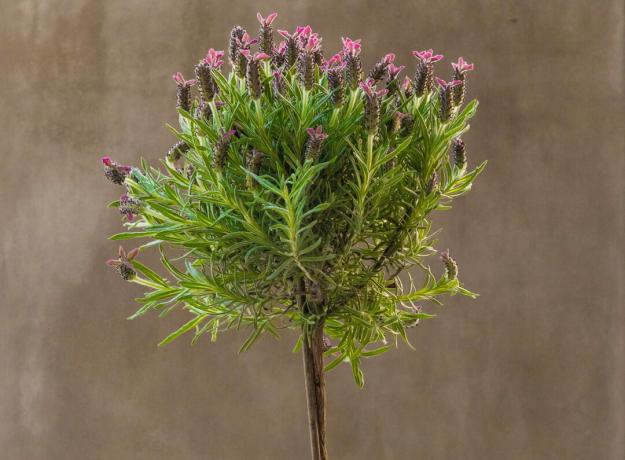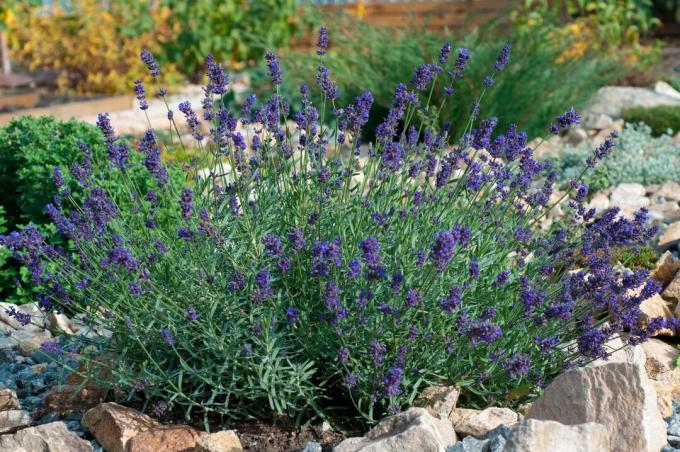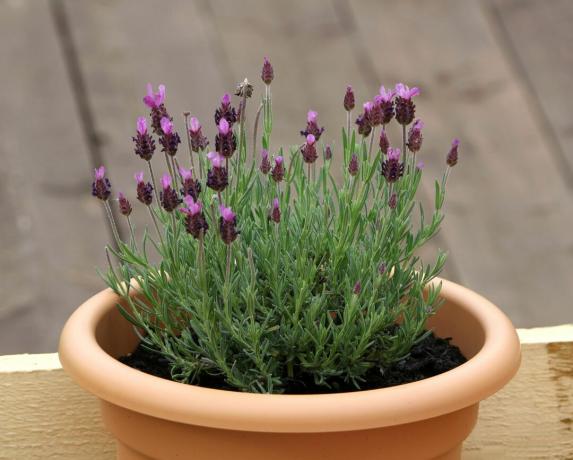When you think of lavender, you probably think of wide beds full of purple flowers. We show that lavender can also be planted as a tree in beds and pots.

The Lavender Tree (Lavandula) can hardly be found in domestic gardens. The designation as a tree or perennial is actually nonsense in this context, because botanically, lavender is one of the subshrubs. These naturally lignify with increasing age and can even form a trunk with appropriate training. Such a lavender as a standard is definitely a special eye-catcher for the garden or on the balcony. The planting and care of the lavender tree differs only slightly in the procedure of a lavender in the form of a bush. In this article we have summarized the most important points so that this rarity may soon be found in your garden. More general information about the lavender can also be found here.
contents
- Plant a lavender tree in the bed
- Planting a lavender tree in a pot
-
Cultivate the lavender tree
- Water the lavender tree
- Fertilize lavender tree
- Pruning lavender tree
- Lavender Tree: Suitable lavender varieties and species
Basically, when planting the lavender tree, the same rules apply as for lavender in general. Not all varieties tolerate the cold temperatures outdoors in our latitudes. Therefore, at least a temporary cultivation in the pot may be necessary. In the following we will explain what you need to consider when planting in the bed and in the pot.
Plant a lavender tree in the bed
Whether the standard is hardy depends on the lavender variety from which it was pulled. The only hardy species is probably only the real lavender (Lavandula angustifolia). Varieties of spike lavender (Lavandula latifolia) and des French lavender (Lavandula stoechas) need special protective measures to survive the cold months outdoors unscathed.

Once the right variety has been found, you should choose a warm, sunny spot with permeable, rather nutrient-poor soil for your lavender tree. You can mix heavy soil with some sand if necessary. When planting the lavender tree, make sure that there is a sufficiently large planting hole and sufficient distance to other plants.
A detailed guide to plants of lavender can be found in our special article.
Planting a lavender tree in a pot
If you prefer to be on the safe side, you can also cultivate your lavender tree in a pot or bucket all year round. In the fall, you can easily move it to cool winter quarters in the house or garage. A sheltered place in the garden or on the balcony is suitable as a location for the summer months. When planting, however, you should make sure that the planter is of sufficient size, because the roots of lavender need a lot of space. It is best to fill the bucket with a rather nutrient-poor substrate. A high-quality herbal soil like this is ideal for this Plantura Organic Herb & Seed Soil. For a higher permeability, you can add sand to the substrate.
You can find tips and tricks for care in our special article on the subject Lavender in the pot.

Cultivate the lavender tree
With regard to lavender care, the same rules apply as for any other lavender. We have summarized the most important points for you below:
Water the lavender tree
When cultivating in the garden bed, you only need to water lavender during prolonged dry periods, whereas the lavender tree should be watered more regularly. When cultivating in pots, however, make sure there is sufficient water drainage, because the lavender tree does not tolerate waterlogging very well.
Fertilize lavender tree
The Mediterranean herb naturally grows on nutrient-poor soil. A one-time fertilization when planting is therefore more than sufficient. In the following years, an annual fertilizer application at the beginning of the growth phase (March/April) is sufficient. It is best to use a fertilizer with an organic long-term effect in order to provide your lavender tree with sufficient nutrients over a longer period of time. Our 100 percent animal-free is ideal Plantura organic universal fertilizer. In pot culture, an additional second fertilization at the beginning of flowering (end of June/beginning of July) optimally supports your lavender tree.

Pruning lavender tree
Lavender is usually only known as a bushy shrub. But so that you can enjoy your lavender tree for a long time, you should cut it regularly, so that the high trunk does not run wild and, in the worst case, returns to its natural growth form falls behind. Basically, the same rules should be followed as with normal lavender. When cutting the lavender tree, you only have to trim the crown. In spring (March/April), when no more frost is to be expected, about one to two thirds of the new shoots can be cut back, making sure that the crown is as round as possible. You can make a second cut after flowering up to the beginning of August at the latest. With this summer pruning, only the faded stems are then cut off to stimulate a second flowering. However, always be careful not to cut into the old wood.
For more information on the correct Care of lavender you'll find here.
Lavender Tree: Suitable lavender varieties and species
In principle, any type of lavender can be grown as a standard. Vigorous varieties are particularly suitable here. But patience is required here, because a lavender bush or cutting cannot be grown into a handsome lavender tree overnight. For a few years you have to cut back the lavender again and again and pay attention to optimal care.

We can recommend the following types of lavender:
- 'Hidcote Blue': Proven English variety of real lavender with dark blue-violet flowers; strongly fragrant; slow and compact growing.
- 'Dwarf Blue': Medium-tall variety of true lavender with grey-green foliage and violet flowers; is well suited as a bed border and scented hedge.
- 'anouk': French lavender with dark violet flowers; long flowering period from May to August; bushy growth; intense, pleasant scent
A comprehensive collection of Varieties of True Lavender you'll find here.
